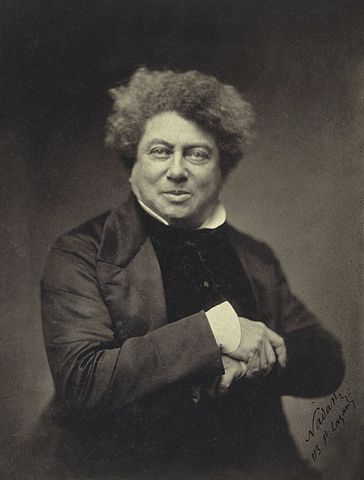THE COUNT OF MONTE CRISTO - THE OPERA
How the opera came to be written
How the opera came to be written - a personal note

Alexandre Dumas père in 1855
There were two inspirations: one literary, the other pragmatic. The poetic one arose from a family holiday in 2003, when my wife and I, with our then young daughter, drove to Italy for a holiday. One of our stopping-off points was Marseilles, and my wife pointed out that this was the setting for The Count of Monte Cristo and that we could visit the Château d'If, where Dantès was imprisoned. This meant very little to me at the time; I had neither read the book nor seen any of the (many) film versions, but I decided to take the book (in French, as a way of keeping my hand in at French) as my holiday reading. I was a little disconcerted when I discovered that the book came in two volumes, each of them over 700 pages long, but I bought Volume 1 and started reading it. I was soon hooked. When we returned from holiday, I promptly bought Volume 2 and devoured that as well. I started musing on how one would make an operatic version of the story, and was surprised, when Googling, to find that no-one had written one, though there is an American musical version.
The pragmatic inspiration concerned computer software. In the early days of personal computers, when I first came across word processors, I remember thinking "wouldn't it be marvellous if there were an equivalent for music?" Now of course there is. For some time, I had used various music programs, starting with one which ran on an Amstrad PCW, but until I purchased Sibelius in 2004, I had not had access to a program capable of handling a full orchestral score. As a bonus, it could also produce a tolerable sound playback of the score, which I found useful in several ways: for spotting wrong notes, for getting a feel for the pacing and structure of what I had written without having to try to play it myself, and, sometimes, as a morale-booster!
I had never written anything lasting longer than about ten minutes, nor, apart from the odd short arrangement, had I written for full orchestra. When I first started sketching ideas for the opera, I never thought it would be finished. I did at least have a pretty good idea of the finished scenario, which involved cutting the original down to manageable proportions, omitting many scenes and dispensing with some characters altogether. The libretto was written as I went along, a little before the music. One advantage of being your own librettist is that you can change the words when you come to set them, and I often did this. I gradually got more and more involved in the project, and it became something of an obsession. Progress was slow, particularly at the beginning. I had a full time job, so composition was done in the evening and at weekends, which meant a lot of stopping and starting.
The opera is dedicated to my wife and daughter, and to the horses which kept them occupied while I was writing it.
It was of course a completely mad idea to write something on such a large scale without any prospect of getting it performed, but it was something I wanted to do, and – who knows? – perhaps someone will read this and decide to put it on....
Peter Smith